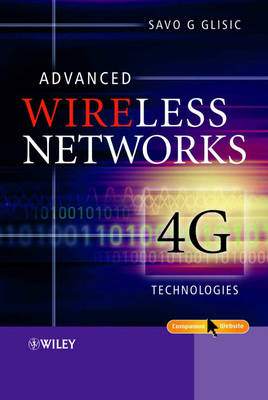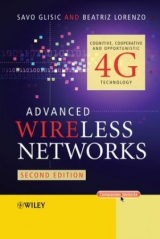
Advanced Wireless Networks
John Wiley & Sons Ltd (Verlag)
978-0-470-01593-3 (ISBN)
- Titel erscheint in neuer Auflage
- Artikel merken
The major expectation from the fourth generation (4G) of wireless communication networks is to be able to handle much higher data rates, allowing users to seamlessly reconnect to different networks even within the same session. "Advanced Wireless Networks" gives readers a comprehensive integral presentation of the main issues in 4G wireless networks, showing the wide scope and inter-relation between different elements of the network. This book adopts a logical approach, beginning each chapter with introductory material, before proceeding to more advanced topics and tools for system analysis. Its presentation of theory and practice makes it ideal for readers working with the technology, or those in the midst of researching the topic. It covers mobile, WLAN, sensor, ad hoc, bio-inspired and cognitive networks as well as discussing cross-layer optimisation, adaptability and reconfigurability. It includes hot topics such as network management, mobility and hand-offs, adaptive resource management, QoS, and solutions for achieving energy efficient wireless networks.
It discusses security issues, an essential element of working with wireless networks and supports the advanced university and training courses in the field and includes an extensive list of references. Providing comprehensive coverage of the current status of wireless networks and their future, this book is a vital source of information for those involved in the research and development of mobile communications, as well as the industry players using and selling this technology. Companion website features three appendices: Components of CRE, Introduction to Medium Access Control and Elements of Queueing Theory.
Savo Glisic is Professor of Telecommunications at the University of Oulu in Finland. He obtained his PhD from Crenfield Institute of Technology, UK, before pursuing post doctoral studies at the University of California at San Diego, USA. His areas of interest include radio resource management in wireless mobile IP networks, network management, symbol synchronization in digital communications, automatic decision threshold level control (ADTLC) and frequency hopping modulation for wireless ad hoc networks. He has vast international experience in the field of telecommunications and has published prolifically on the subject, including two previous books with J.Wiley.
Preface.1 Fundamentals.1.1 4G Networks and Composite Radio Environment.1.2 Protocol Boosters.1.3 Hybrid 4G Wireless Network Protocols.1.4 Green Wireless Networks.References.2 Physical Layer and Multiple Access.2.1 Advanced Time Division Multiple Access-ATDMA.2.2 Code Division Multiple Access.2.3 Orthogonal Frequency Division Multiplexing.2.4 Multicarrier CDMA.2.5 Ultrawide Band Signal.2.6 MIMO Channels and Space Time Coding.References.3 Channel Modeling for 4G. 3.1 Macrocellular Environments (1.8 GHz).3.2 Urban Spatal Radio Channels in Macro/MicroCell Environment (2.154 GHz).3.3 MIMO Channels in Micro- and PicoCell Environment (1.71/2.05 GHz).3.4 Outdoor Mobile Channel (5.3 GHz).3.5 Microcell Channel (8.45 GHz).3.6 Wireless MIMO LAN Environments (5.2 GHz).3.7 Indoor WLAN Channel (17 GHz).3.8 Indoor WLAN Channel (60 GHz).3.9 UWB Channel Model.References.4 Adaptive and Reconfigurable Link Layer.4.1 Link Layer Capacity of Adaptive Air Interfaces.4.2 Adaptive Transmission in Ad Hoc Networks.4.3 Adaptive Hybrid ARQ Schemes for Wireless Links.4.4 Stochastic Learning Link Layer Protocol.4.5 Infrared Link Access Protocol.References.5 Adaptive Medium Access Control.5.1 WLAN Enhanced Distributed Coordination Function.5.2 Adaptive MAC for WLAN with Adaptive Antennas.5.3 MAC for Wireless Sensor Networks.5.4 MAC for Ad Hoc Networks.References.6 Teletraffic Modeling and Analysis.6.1 Channel Holding Time in PCS Networks.References.7 Adaptive Network Layer.7.1 Graphs and Routing Protocols.7.2 Graph Theory.7.3 Routing with Topology Aggregation.7.4 Network and Aggregation Models.References.8 Effective Capacity.8.1 Effective Traffic Source Parameters.8.2 Effective Link Layer Capacity.References.9 Adaptive TCP Layer.9.1 Introduction.9.2 TCP Operation and Performance.9.3 TCP for Mobile Cellular Networks.9.4 Random Early Detection Gateways for Congestion Avoidance.9.5 TCP for Mobile Ad Hoc Networks.References.10 Crosslayer Optimization.10.1 Introduction.10.2 A Cross-Layer Architecture for Video Delivery.References.11 Mobility Management.11.1 Introduction.11.2 Cellular Systems with Prioritized Handoff.11.3 Cell Residing Time Distribution.11.4 Mobility Prediction in Pico- and MicroCellular Networks.Appendix: Distance Calculation in an Intermediate Cell.References.12 Adaptive Resource Management.12.1 Channel Assignment Schemes.12.2 Resource Management in 4G.12.3 Mobile Agent-based Resource Management.12.4 CDMA Cellular Multimedia Wireless Networks.12.5 Joint Data Rate and Power Management.12.6 Dynamic Spectra Sharing in Wireless Networks.References.13 Ad Hoc Networks.13.1 Routing Protocols.13.2 Hybrid Routing Protocol.13.3 Scalable Routing Strategies.13.4 Multipath Routing.13.5 Clustering Protocols.13.6 Cashing Schemes for Routing.13.7 Distributed QoS Routing.References.14 Sensor Networks.14.1 Introduction.14.2 Sensor Networks Parameters.14.3 Sensor Networks Architecture.14.4 Mobile Sensor Networks Deployment.14.5 Directed Diffusion.14.6 Aggregation in Wireless Sensor Networks.14.7 Boundary Estimation.14.8 Optimal Transmission Radius in Sensor Networks.14.9 Data Funneling.14.10 Equivalent Transport Control Protocol in Sensor Networks.References.15 Security.15.1 Authentication.15.2 Security Architecture.15.3 Key Management.15.4 Security Management in GSM Networks.15.5 Security Management in UMTS.15.6 Security Architecture for UMTS/WLAN Interworking.15.7 Security in Ad Hoc Networks.15.8 Security in Sensor Networks.References.16 Active Networks.16.1 Introduction.16.2 Programable Networks Reference Models.16.3 Evolution to 4G Wireless Networks.16.4 Programmable 4G Mobile Network Architecture.16.5 Cognitive Packet Networks.16.6 Game Theory Models in Cognitive Radio Networks.16.7 Biologically Inspired Networks.References.17 Network Deployment.17.1 Cellular Systems with Overlapping Coverage.17.2 Imbedded Microcell in CDMA Macrocell Network.17.3 Multitier Wireless Cellular Networks.17.4 Local Multipoint Distribution Service.17.5 Self-organization in 4G Networks.References.18 Network Management.18.1 The Simple Network Management Protocol.18.2 Distributed Network Management.18.3 Mobile Agent-based Network Management.18.4 Ad Hoc Network Management.References.19 Network Information Theory.19.1 Effective Capacity of Advanced Cellular Networks.19.2 Capacity of Ad Hoc Networks.19.3 Information Theory and Network Architectures.19.4 Cooperative Transmission in Wireless Multihop Ad Hoc Networks.19.5 Network Coding.19.6 Capacity of Wireless Networks Using MIMO Technology.19.7 Capacity of Sensor Networks with Many-to-One Transmissions.References.20 Energy-efficient Wireless Networks.20.1 Energy Cost Function.20.2 Minimum Energy Routing.20.3 Maximizing Network Lifetime.20.4 Energy-efficient MAC in Sensor Networks.References.21 Quality-of-Service Management.21.1 Blind QoS Assessment System.21.2 QoS Provisioning in WLAN.21.3 Dynamic Scheduling on RLC/MAC Layer.21.4 QoS in OFDMA-based Broadband Wireless Access Systems.21.5 Predictive Flow Control and QoS.References.Index.
| Erscheint lt. Verlag | 7.4.2006 |
|---|---|
| Zusatzinfo | Illustrations, maps |
| Verlagsort | Chichester |
| Sprache | englisch |
| Maße | 181 x 250 mm |
| Gewicht | 1824 g |
| Einbandart | gebunden |
| Themenwelt | Technik ► Elektrotechnik / Energietechnik |
| Technik ► Nachrichtentechnik | |
| ISBN-10 | 0-470-01593-4 / 0470015934 |
| ISBN-13 | 978-0-470-01593-3 / 9780470015933 |
| Zustand | Neuware |
| Haben Sie eine Frage zum Produkt? |
aus dem Bereich



